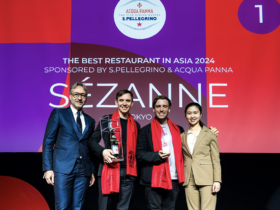Champagne may be seen as the king of sparkling wine but the Italians are giving the French a run for their money.

At the foothills of the Alps in north-eastern Italy is a region called Veneto. This is where some of the oldest wineries in Italy are giving champagne a run for the money in global markets, with their own bubbly — Prosecco.
Like champagne, which is sparkling wine from the Champagne region of France, Prosecco is classified as a “Protected Designation of Origin” product. This classification for Prosecco is granted only to sparkling wines made from Glera grapes cultivated from Valdobbiadene and Conegliano in Italy using the Charmat process.
There are a few different ways to make wonderful sparkling wines. Between champagne and Prosecco, only two are used: Méthode Champenoise for champagne and Metodo Italiano (Charmat process) for Prosecco. The difference is in the fermentation process.
Methode Champenoise

With Methode Champenoise, the wine undergoes primary fermentation in the vat and, after bottling, a second fermentation within the bottle. This is a costlier and more exacting process because the amount of sugar in the bottle has to be right for fermentation, and it takes over a year to complete.
As a result, champagne has more pressure in the bottle, higher alcohol content and more complexity.
Charmat Process
Prosecco is fermented in stainless steel vats and bottled without additional fermentation. It’s a simpler, faster and more economical process.
Because there is no bottle fermentation, it’s generally best to drink Prosecco when the wine is young. The exception is premium Proseccos – typically vintage and can last for three years or so.
Prosecco Catching Up with Champagne
While champagne has enjoyed legendary popularity, Prosecco has had an uphill struggle. Today, however, Prosecco, traditionally a provincial product, is now finding audiences around the world.
As a category, Prosecco has also evolved over generations. Today, greater emphasis is placed on producing quality, and marketing it globally. That’s what Primo Franco, third-generation vintner, has been doing for his family’s winery — Nino Franco.

Three Prominent Proseccos
Primo introduced me to Nino Franco’s Rustico Prosecco NV, Primo Franco 2014, and Grave di Stecca 2010.
The Rustico is a multi-vintage (mixed from different years’ wines) Prosecco, from Glera grapes, grown on the hillside at medium elevation. It is straw-coloured, has fine bubbles and an alcohol content of 11 per cent. It tasted fruity and sweet, while its foaminess was quite velvety and created a nice sensation on the palate.
The Primo Franco 2014, with an alcohol content of 10.5 per cent, is a vintage but should be enjoyed quite quickly. It has a more intense bouquet with complex fruit and grape flavours and is much sweeter.
Lastly, Nino Franco Grave Di Stecca 2010 is a brut vintage Prosecco, which Primo considers grand cru (meaning “great growth”; signifying good vineyard reputation) with alcohol content of 12 per cent. According to the vintner’s description, it is made from ancient vines “on the slopes at the foot of the Pre-Alps” and “this vineyard enjoys a special microclimate”.
The bubbly tasted less sweet and heavier than the rest but still lighter than champagne. Among the three, it also had fuller flavours, especially of ripe fruit and herbs.
Alternative to Champagne?
Whether it’s deserved or not, champagne brings prestige to special occasions — at a price. Nonetheless, I enjoyed the Prosecco. Not only were they refreshing and full of flavours, Prosecco is also lighter on the wallet. Bubbly is no longer just for special occasions.
By Frank Young
Nino Franco Prosecco prices start at $46 per bottle and can be found at eWineasia.com.
ADVERTISEMENTS










Leave a Reply